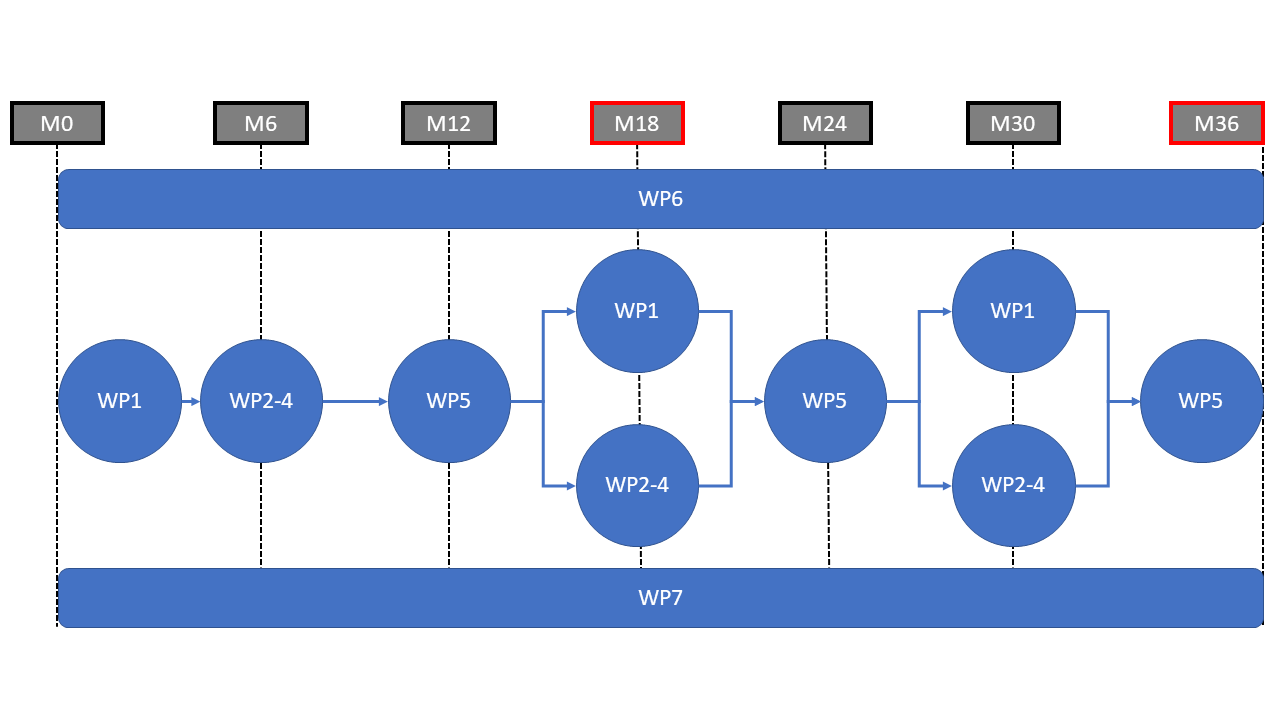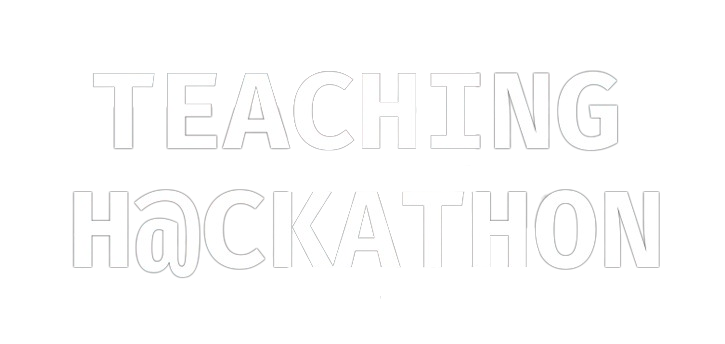Based on the overall strategy for the TEACHING work plan, the work to be performed in the project will be realised in a set of work packages illustrated below.

Work Packages
Duration: 1-36
This work package will provide technical strategy and oversight for all research and development activities throughout the lifecycle of the project. It also will include requirements collection and analysis, state of the art review, and architecture specification production. The activities within this work package will strongly interact with those in the technical WPs providing specifications for the tools and software developed therein and taking care of their smooth integration.
The objectives of this WP are to:
- Review the state-of-the-art, track future technology trends, and identify appropriate hardware platforms, sensors and software tools.
- Identify and track end user and technical requirements, querying use case partners and technical contributors of TEACHING.
- Specify the overall architecture for the TEACHING CPSoS by identifying components, their functionalities and interconnection, ensuring their coherency with the requirements and global architecture.
- Integrate the components/prototypes developed by the technical WPs and setup the integration environment in order to deliver the overall integrated TEACHING CPSoS and its demonstrators.
- Define the data management and integration plans.
D1.1. Report on TEACHING related technologies SoA and derived CPSoS requirements (Lead: HUA; Due: M10; R; P)
D1.2. TEACHING CPSoS architecture and specifications (Lead: HUA; Due: M20; R; P)
D1.3. Report on TEACHING CPSoS integration and on Human Centred Design outcomes (Lead: HUA; Due: M30; R; P)
Duration: 1-36
This WP focuses on the tools and mechanisms enabling the setup and the subsequent exploitation of the TEACHING distributed and heterogeneous computing platform. The resources in TEACHING will include different kinds of computing systems, both traditional ones (ranging from cloud computing platforms to edge machines) and smaller resource/energy-constrained devices, such as IoT, sensors or wearable devices (Obj. 1 and Obj. 2). The WP activities will deal with the application deployment onto the computing platform, the related networks and communications as well as on device programming and data storing. The WP will develop solutions for enabling information exchange, dissemination and gathering among different devices, possibly belonging to different cyber-physical subsystems. The WP will also deal with application deployment and tuning, both in traditional computing solutions as well as on resource/ energy-constrained devices (Obj. 3). Advanced solutions and approaches for the efficient management and processing of data streams will be implemented possibly leveraging existing, state-of-the-art solutions. The activities within this WP will strongly interact with those in the other technical WPs, from WP3 to WP5, with a tighter interaction with WP3.
The objectives of this WP are the following:
- To provide mechanisms and means to ease the efficient exploitation of heterogeneous computational resources, including multi/many cores CPUs, computing accelerators and FPGAs
- To ease the seamless and dynamic exploitation of Cloud and Edge resources, in order to supply the CPSoS of computing power when needed, by utilizing state-of-the-art solutions such as containerization and virtualization techniques
- Definition of proper abstractions for the efficient exploitation, tuning and configuration of energy/performance constrained devices, such as IoT, sensors and wearable devices.
- Implementation of management strategies and load balancing trade-offs between edge and cloud computing
- Development of solutions enabling the decentralized communication among different devices either belonging to the same cyber-physical subsystem (intra-subsystem communication) or to different subsystems (inter-subsystem communication), supporting the detection of self-emerging behaviours.
- Provide mechanisms and solutions for the efficient management, processing and transmission of data streams, both within the same cyber-physical subsystem and across different subsystems
D2.1. State-of-the-art analysis and preliminary requirement specifications for the computing and communication platform (Lead: CNR; Due: M10; R; P)
D2.2. Refined requirement specifications and preliminary release of the computing and communication platform (Lead: CNR; Due: M20; DEM; P))
D2.3. Final release of the computing and communication platform (Lead: CNR; Due: M30; DEM; P)
Duration: 1-36
This work package focuses on the development of methodologies, architectural frameworks and tools to enforce dependable engineering (mainly focusing on safety and security properties) of novel CPSoS (Obj. 4). In this context, the whole industrial environment (e.g. road network, avionic environment, industrial domain network) must be kept in mind and designed to prevent, detect and recover from the intentional and unintentional misuse. The goal is to identify gaps with existing solutions for the management of CPSoSs throughout their life cycle including design and operational phases (architectural frameworks, conceptual models, process frameworks etc..). Based on this analysis, architectural, process and development framework have to be developed to support automated dependability evaluation of CPSoS (Obj. 5). Thereby the WP covers methods, tools, and the overarching methodology. The objectives of this WP are to develop:
- Effective communication channels between multiple domains and thus select suitable methods and tools that support the whole system/product lifecycle.
- Best practices and engineering design patterns for dependable CPSoS architectures.
- Approaches to maintain dependability constraints while load balancing between edge and cloud computing.
- Engineering methods aiming for secure integration of distribute (external) information.
- Mechanisms that prevent from unintentional (e.g. HW/SW faults) or intentional (e.g. jamming attacks) errors and ensure safety and security of the CPSoS.
- Engineering methods that support integration of novel (distributed) AI approaches in dependable manner.
D3.1. Initial Report on Engineering Methods and Architecture Patterns of Dependable CPSoS (Lead: TUG; Due: M10; R; P)
D3.2. Interim Report on Engineering Methods and Architecture Patterns of Dependable CPSoS (Lead: TUG; Due: M20; DEM; P)
D3.3. Final Report on Engineering Methods and Architecture Patterns of Dependable CPSoS (Lead: TUG; Due: M36; DEM; P)
Duration: 1-36
This work package will design methodologies and realize tools to create the TEACHING Artificial Intelligence as a Service (AIaaS) software infrastructure for the CPSoS and its applications, together with the human-centric adaptive personalization mechanisms (Obj. 6). As such, the activities within this work package are summarized as follows:
- Provide a toolkit implementing distributed intelligence in terms of an AI as a service (AIaaS) system for CPSoS applications.
- Develop AI methodologies specialized in the recognition and characterization of human physiological, cognitive and emotional state from heterogeneous sensing devices.
- Realizing functionalities to self-adapt and personalize AI models exploiting the human state in a non-obtrusive fashion.
- Design privacy aware AI methodologies to be bundled within the AI as a service toolkit.
D4.1. Initial report on the AIaaS system (Lead: UNIPI; Due: M10; R; P)
D4.2. Report on integrated mockup of the AIaaS system (Lead: UNIPI; Due: M20; DEM; P)
D4.3. Report on Final release of the AIaaS system (Lead: UNIPI; Due: M36; DEM; P)
Duration: 1-36
The overarching objective of this WP is to integrate in the project use cases the autonomous driving and aviation functions, which are supported by AI techniques and which are intended to result with drastic increase of CPSoS
performance, functionality and customization capabilities. The integration is orientated towards tailoring of relevant AIaaS functionalities for industrial environment and preparation for sustainable exploitation in the post-project phase (Obj. 7). The integration is based on usage of outputs from WP2-4, which address critical points and provide innovative solutions. The WP sub-objectives are:
- Design and define the architecture and requirements of the TEACHING avionics and automotive use cases
- Data acquisition for enabling development, refinement and assessment of the individual software components in the AIaaS system.
- Integration of the autonomous driving and aviation functions supported by AI in virtual environments to enable evaluation of physical interactions and readiness for industrial environment.
- Integration of autonomous driving and aviation functions supported by AI into physical demonstrators.
- Assessment of safety aspects arising from the integration activities.
- Extensive demonstrator testing activities adopting the proposed control strategies.
D5.1. Initial use case specifications (Lead: AVL; Due: M6; R; P)
D5.2. Preliminary use case deployment, implementation and integration report with related dataset release (Lead: AVL; Due: M20; DEM; P)
D5.3. AI models training dataset (Lead: AVL; Due: M24; ORDP; P)
D5.4. Use case evaluation report (Lead: AVL; Due: M24; R; P)
Duration: 1-36
The main objective of this WP is to deliver the outcomes of TEACHING to citizens, market/stakeholders and research community (Obj. 8). To this end, this work package will aim at:
- Maximizing the impact of the project aligning business opportunities with the technical and research activity.
- Assisting and complementing the technical development with the business perspective particularly, relating to future
- uptake and sustainability.
- Studying the external context for TEACHING results, providing input and requirements relating to market needs and
- trends and defining the market context for exploitation.
- Ensuring proper communication of the project results and subsequently raising awareness to the scientific, industrial,
- and general public communities.
- Following, contributing to, promoting and ensuring usage of the corresponding relevant standards, while also supporting the liaison and collaboration activities with other EC funded related projects and initiatives.
D6.1. Initial plans for stakeholders’ engagement, dissemination and exploitation of results (Lead: ITML; Due: M3; R; P)
D6.2. Data Management Plan (Lead: UNIPI; Due: M6; R; CO)
D6.3. Mid-term update of stakeholders’ engagement plan, dissemination and exploitation mid-term reports (Lead: ITML; Due: M20; R; P)
D6.4. Market analysis, business plan and long-term sustainability report (Lead: ITML; Due: M20; R; P)
D6.5. Final dissemination and exploitation report (Lead: ITML, Due: M36; R; P)
D6.6. TEACHING contribution to standards report (Lead: ITML, Due: M36; R; CO)
Duration: 1-36
The main objective of this work package is to perform a coordination of the project to ensure TEACHING success. This WP will focus on:
- Ensuring TEACHING to meet its objectives and work plan.
- Overall administrative and financial project management for a successful achievement of TEACHING goals.
- Defining and implementing communication procedures to be followed within the project and with external
- stakeholders.
- Scheduling and organizing all project meetings.
- Setting up and maintaining the information and communication flow among partners and also the liaison between the Project Officer from the European Commission and all the project partners.
- Providing overall technical coordination ensuring technical cohesion between RTD activities and efficient coordination work.
D7.1. Project Management Plan (Lead: UNIPI; Due: M3; R; CO)
D7.2. Midterm management report (Lead: UNIPI; Due: M20; R; CO)
D7.3. Final management report (Lead: UNIPI; Due: M36; R; CO)
D7.4. Final report on the distribution of the Community contribution (Lead: UNIPI; Due: M36; R; P)
D7.5. Ethics compliance and monitoring (Lead: UNIPI, Due: M10; R; CO)



